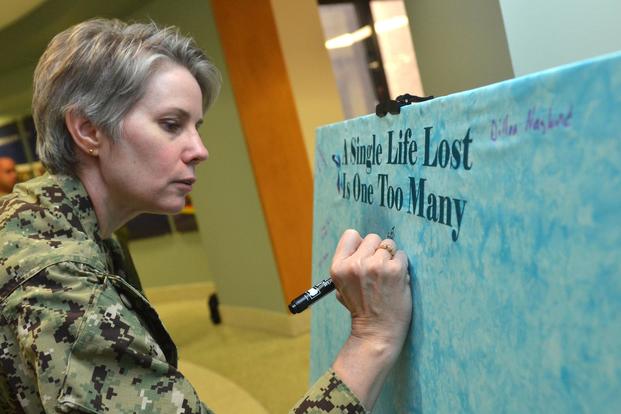Editor’s Note: This story has been updated to include Army year-end totals.
The U.S. military finished 2018 with a troubling, sad statistic: It experienced the highest number of suicides among active-duty personnel in at least six years.
A total of 321 active-duty members took their lives during the year, including 57 Marines, 68 sailors, 58 airmen, and 138 soldiers.
The deaths equal the total number of active-duty personnel who died by suicide in 2012, the record since the services began closely tracking the issue in 2001.
Suicide continues to present a challenge to the Pentagon and the military services, which have instituted numerous programs to save lives, raise awareness and promote prevention. Marine Corps Commandant Gen. Robert Neller, in his 2019 guidance to Marines released Friday, urged them to consider the lasting impact that a "permanent solution to a temporary problem" can have.
"We pride ourselves on building tough, resilient, mission-focused Marines, but we also pride ourselves on taking care of our own. ... While there is no dishonor in coming up short or needing help, there is no honor in quitting. MARINES NEVER QUIT ON EACH OTHER!" Neller wrote.
The Corps' 57 active-duty deaths represent a 25 percent increase from 2017, the highest number of suicides since the service began closely tracking them in 2001.
The Corps also lost 18 Reserve members in 2018 to suicide, second only to 2016, when 19 Marine reservists took their own lives. The service began tracking such deaths in the reserve component in 2012.
The number of Navy suicides -- 68 sailors in 2018, up from 65 in 2017 -- also was a record and marked a steep increase in the suicide rate among active-duty Navy personnel. Just five years ago, when the Navy recorded 41 suicides among active-duty sailors, the suicide rate was 12.7 deaths per 100,000 sailors; now the rate is more than 20 deaths per 100,000. The Navy is the only service that publishes its data, including calculated suicide rates, online.
According to Air Force officials, 58 active-duty airmen took their lives, while three Reserve members died by their own hands. The number represents a decline from previous years, down from 63 in 2015 and 2017, and 61 in 2016, but is still troubling, said Brig. Gen. Michael Martin, director of Air Force Integrated Resilience.
"We are not satisfied with flat-lined suicide death numbers. The Air Force is dedicated to a comprehensive, leadership-driven strategy with the ultimate goal of supporting airmen and their families early with a robust network and never losing another airman to suicide," Martin said in a statement.
The Army referred requests on the data to the Defense Suicide Prevention Office, which has not published the year-end totals. But it also noted in an email that 138 soldiers died as the result of suicide in 2018.
Those deaths mark the highest number of suicides in the active-duty Army since 2012, but are markedly lower than that year, when 165 soldiers took their own lives.
Army spokeswoman Col. Kathleen Turner said the loss of any soldier or family member is a tragedy.
"Like the rest of America, the Army continues to grapple with the loss of too many of our people to suicide," Turner said. "While the Army has made progress, more work needs to be done. We must continue to ensure commanders have the policies and resources they need to prevent suicides, that all leaders have the tools to identify soldiers who are suffering and to positively intervene, and that all soldiers view seeking mental health care as a sign of strength."
The U.S. military is not unique in struggling with the impact of suicide. According to the Centers for Disease Control and Prevention, suicide rates in the U.S. have increased in nearly every state since 1999. And while mental health conditions often are seen as the cause of suicide, it's "rarely caused by any single factor," according to the CDC.
DSPO has been without a permanent chief since October 2017, when former director Keita Franklin moved to head the Department of Veterans Affairs' suicide prevention office.
It last sponsored a conference on suicide prevention in August 2017 and held a suicide prevention month in September 2018, which included hosting an outreach event, attending resource fairs at various locations, and promoting awareness campaigns.
The suicide rates for the military services -- data that help Pentagon leadership understand the scope of the issue compared with civilian populations -- are not generally published by the individual services. They are calculated based on the number of deaths and population of the services and published in an annual DoD Suicide Event Report, or DoDSER.
The last DoDSER was for 2016, when the rate across all the military services was 21.1 deaths per 100,000 active-duty service members.
Rates for the individual services that year were:
- 19.4 per 100,000, based on 61 deaths, for the Air Force;
- 26.7 per 100,000, based on 127 deaths, for the Army;
- 15.3 per 100,000 based on 50 deaths, for the Navy;
- and 21 per 100,000, based on 37 deaths, for the Marine Corps.
According to the Navy, the adjusted rate of suicide in the civilian population for men of the same age as those who serve in the armed forces, is 26.8 per 100,000.
Military personnel who need need help can call the Veterans Crisis Line at 800-273-8255. Suicidal troops and veterans can call the Military Crisis Line at 800-273-8255, press 1, for assistance, or text 838255.
-- Staff reporter Oriana Pawlyk contributed to this report.
-- Patricia Kime can be reached at Patricia.Kime@Military.com. Follow her on Twitter @patriciakime.
Correction: This story was updated to reflect the total number of Army suicides in 2018. The Army provided the year-end figures in an email to Military.com that weren't included in the original version.













